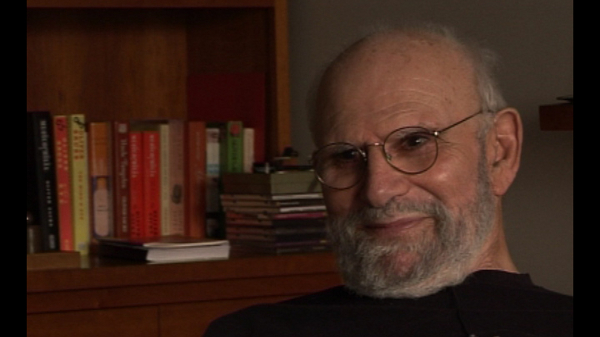NEXT STORY

Inspecting my grotesquely broken leg
RELATED STORIES

NEXT STORY

Inspecting my grotesquely broken leg
RELATED STORIES


|
Views | Duration | |
|---|---|---|---|
| 141. Reasons for agreeing to Awakenings documentary | 304 | 01:43 | |
| 142. Success of Awakenings documentary | 466 | 00:38 | |
| 143. 'Witty Ticcy Ray' | 783 | 01:38 | |
| 144. My new interest in Tourette’s syndrome | 474 | 02:12 | |
| 145. My dream: The Tourette’s Syndrome Society | 291 | 01:25 | |
| 146. Working on Ward 23 with autistic, psychotic and retarded patients | 495 | 02:56 | |
| 147. 'Therapeutic punishment' | 340 | 01:53 | |
| 148. Appetitive and consummatory states | 286 | 02:10 | |
| 149. The accidents in Norway | 354 | 03:50 | |
| 150. Inspecting my grotesquely broken leg | 311 | 03:17 |


I took off for Norway soon afterwards because I thought that would be a good peaceful place to write my diatribe. But, I had a series of accidents one after the other, gradually getting more and more serious. One of them, which shook me up a good deal and could have been the end of me, was when I lost an oar... I’d rowed out on the fjord, on Hardangerfjord, and I lost an oar, but I somehow made my way back with one oar. And then, the next day, I climbed the mountain, and... I don’t know how much of the story I told. The next day I started out for a little mountain climbing. I saw a notice at the bottom of the mountain which as far as I could construe, it said beware of the bull, and it also had a little jolly cartoon of a man being tossed by a bull. I thought of this as a sort of Norwegian sense of humour, you know how they are in Scandinavia. How could you have a bull on a... on a mountain, or any livestock on a mountain?
So I... I was strong and energetic then, and I used my gymnasium-trained strength to... to ascend the mountain and climb up the mountain. At first I... I was a little apprehensive that I might meet the bull, and then I dismissed this from my mind, a lot of nonsense, but... but it wasn’t a lot of nonsense. And I came, sort of, nonchalantly, and gaily, and swingingly, round one boulder, one big boulder, and found myself face-to-face with a bull sitting on the path, face-to-face, snout-to -snout. I... terror is... is too mild a word for what I felt, and... and the sight of this, and the feeling of it, induced a sort of hallucination. The bull’s face seemed to expand until I could see nothing else. But then, very daintily, as if I just decided to end my walk at that point, I turned round and descended the path. But then, alas, my nerve broke, panic took over me, and I started to run on this icy muddy mountain path, and faster because I heard heavy, thudding hooves, and heavy breathing behind me, or I thought I did, it was probably my own breathing, and my own thudding, and then suddenly, I don’t know how it happened, I was at the bottom of a cliff with my left leg twisted grotesquely underneath me.
Oliver Sacks (1933-2015) was born in England. Having obtained his medical degree at Oxford University, he moved to the USA. There he worked as a consultant neurologist at Beth Abraham Hospital where in 1966, he encountered a group of survivors of the global sleepy sickness of 1916-1927. Sacks treated these patients with the then-experimental drug L-Dopa producing astounding results which he described in his book Awakenings. Further cases of neurological disorders were described by Sacks with exceptional sympathy in another major book entitled The Man Who Mistook His Wife For A Hat which became an instant best seller on its publication in 1985. His other books drew on his rich experiences as a neurologist gleaned over almost five decades of professional practice. Sacks's work was recognized by prestigious institutions which awarded him numerous honours and prizes. These included the Lewis Thomas Prize given by Rockefeller University, which recognizes the scientist as poet. He was an honorary fellow of both the American Academy of Arts and Letters and the American Academy of Arts and Sciences, and held honorary degrees from many universities, including Oxford, the Karolinska Institute, Georgetown, Bard, Gallaudet, Tufts, and the Catholic University of Peru.
Title: The accidents in Norway
Listeners: Kate Edgar
Kate Edgar, previously Managing Editor at the Summit Books division of Simon and Schuster, began working with Oliver Sacks in 1983. She has served as editor and researcher on all of his books, and has been closely involved with various films and adaptations based on his work. As friend, assistant, and collaborator, she has accompanied Dr Sacks on many adventures around the world, clinical and otherwise.
Tags: Norway, Hardangerfjord
Duration: 3 minutes, 50 seconds
Date story recorded: September 2011
Date story went live: 02 October 2012